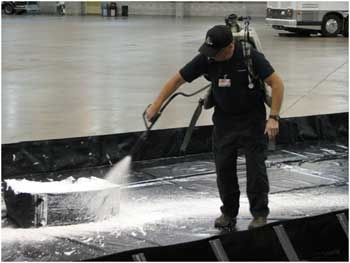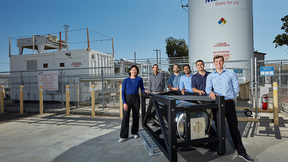LLNL partners with airports and DHS to keep planes flying
 (Download Image)
Portable decontamination equipment was demonstrated in June as part of the Chemical Weapon Agent/Toxic Industrial Chemical Remediation and Demonstration Workshop for Midwest Airports.
(Download Image)
Portable decontamination equipment was demonstrated in June as part of the Chemical Weapon Agent/Toxic Industrial Chemical Remediation and Demonstration Workshop for Midwest Airports.
LLNL's ongoing collaborative work to address technical remediation challenges in returning critical transportation facilities to service following release of a chemical weapon agent (CWA) or toxic industrial chemical (TIC) recently culminated in a workshop for Midwest airports at the Colorado Convention Center in Denver.
The workshop, called the CWA/TIC Remediation and Demonstration Workshop, was held last month as a part of the Department of Homeland Security (DHS) Chemical Operational Technology Demonstration (Chem OTD) Project.
In close coordination with colleagues from the Sandia, Oak Ridge and Pacific Northwest national laboratories and project sponsors from DHS, LLNL hosted and led the two-day workshop and demonstration for 125 participants.
"The Laboratory's expertise from its scientific and environmental regulatory organizations was a key to making this workshop a success," said Ellen Raber, LLNL deputy program director for counterterrorism who was one of the lead speakers.
The participants included key facility and response personnel from Chicago O'Hare, Dallas-Ft. Worth and Denver international airports; federal representatives from the U.S. Environmental Protection Agency, the Federal Emergency Management Agency, the Centers for Disease Control and Prevention, and the Transportation Security Administration as well as state and local authorities representing emergency management, public health, fire, law enforcement and hazardous waste management.
The workshop also drew international participants from the United Kingdom and Canada, and is the third in a series of CWA/TIC Remediation events held over the past two years for critical transportation airport hubs across the nation.
The workshop provided a unique opportunity to gather key decision-makers, technical experts, facility operators, and regulatory personnel to jointly conduct exercises about Chem OTD concepts, methods and tools through discussion-based tabletop exercises.
Training also was provided on the near-final national-level policy and guidance document "Remediation Guidance for Major Airports After a Chemical Attack" developed under the Chem OTD Project. Poster sessions and demonstrations afforded participants the opportunity to view current research and analytical results through 22 posters and eight demonstrations.
Among the demonstrations given at the Denver workshop included the EPA's PHILIS mobile lab, the National Guard's 8th WMD Civil Support Team, and two private contractors who demonstrated decontamination equipment and techniques.
Demonstrations also were provided on a suite of software tools (PATH, AWARE, ADVISER, RESTORe, BROOM and VSP) developed by the national labs for planning and conducting recovery operations, and for data acquisition, management and analysis.
Contact
Stephen P Wampler[email protected]
925-423-3107
Tags
Global SecurityScience
Featured Articles







